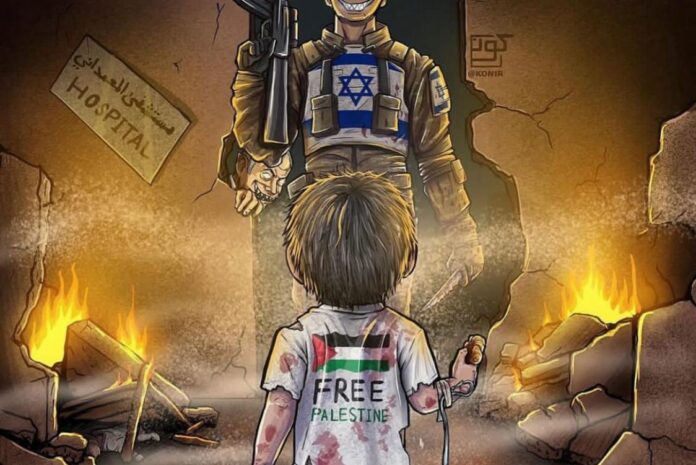In a highly tense and critical situation, Israel has imposed a four-hour window for the remaining civilians trapped within encircled Gaza City to evacuate. Residents who managed to escape the city reported sightings of Israeli tanks positioned for a potential assault.
Israel’s stated intent is to eliminate Hamas Islamists who initiated attacks on Israeli towns one month ago. The conflict began on October 7 when Hamas fighters breached the Gaza fence, resulting in the deaths of 1,400 Israelis, primarily civilians, and the abduction of over 200, according to Israeli reports. In retaliation, Israel has relentlessly struck Gaza with a series of attacks, causing the loss of more than 10,000 lives, with around 40 percent of the casualties being children, according to health officials in Gaza.
UN Human Rights Commissioner Volcker Turk, who recently embarked on a trip to the region, expressed deep concern, stating, “It has been one full month of carnage, of incessant suffering, bloodshed, destruction, outrage, and despair.” Turk’s visit will include a stop at the Rafah crossing, the sole route for aid to enter Gaza, underlining the pivotal role of human rights in resolving the ongoing crisis.
Israel’s ultimatum on Tuesday allowed Gaza City residents to leave from 10:00 a.m. to 2:00 p.m. Residents reported that Israeli tanks have primarily moved during the night, with air and artillery strikes being the primary method used by Israeli forces to pave the way for their ground offensive.
“For your safety, take this next opportunity to move south beyond Wadi Gaza,” the military announced, referencing the wetlands that bisect the strip.
The Israeli army shared footage of hundreds of Gazans forced to relocate.
Hundreds of Gazans are seen with their hands in the air and carrying white flags. pic.twitter.com/ahngg139zI
— Clash Report (@clashreport) November 7, 2023
Adam Fayez Zeyara, a resident who managed to escape, described the journey as “the most dangerous trip in my life.” He recounted sightings of tanks at close range, gruesome scenes of decomposed body parts, and a heavy atmosphere of death.
While Israel’s military operation concentrates on the northern portion of Gaza, the south has not been spared. Palestinian health officials reported at least 23 casualties in two separate Israeli airstrikes early on Tuesday in the southern cities of Khan Younis and Rafah.
Amidst the devastation, Ahmed Ayesh, who was rescued from the wreckage of a house in Khan Younis where 11 people lost their lives, emphasized their civilian status, saying, “We are civilians. This is the bravery of the so-called Israel, they show their might and power against civilians, babies inside, kids inside, and the elderly.”
Prime Minister Benjamin Netanyahu conveyed Israel’s willingness to consider “tactical little pauses” in the fighting to allow hostages to leave or aid to enter. However, he remained firm in rejecting calls for a general ceasefire.
Israel’s military reported capturing a militant compound in the northern Gaza Strip, with plans to target fighters hidden within an intricate network of underground tunnels. Footage released by the military depicted troops using bulldozers to unearth earth and topple walls.
Israeli aircraft also targeted Hamas fighters barricaded in a building near the al-Quds Hospital in Gaza City.
Both Israel and Hamas have resisted mounting appeals for a ceasefire. Israel insists that hostages must be released before any cessation of hostilities, while Hamas refuses to release hostages or halt the conflict while Gaza remains under attack.
The ongoing conflict continues to elicit stories of civilian suffering on both sides, polarizing global opinions over the past month. UN Secretary-General Antonio Guterres described Gaza as becoming a “graveyard for children,” and international organizations have stressed that the current level of aid is far from sufficient to address the crisis.
Calls for an immediate humanitarian ceasefire have grown increasingly urgent. A statement from the heads of several United Nations bodies on Monday declared, “We need an immediate humanitarian ceasefire. It’s been 30 days. Enough is enough. This must stop now.”
The Israeli military has released video footage of its operations, with tanks moving through war-torn streets and troops navigating on foot. Rear Admiral Daniel Hagari, the chief military spokesperson, revealed that the military’s focus is on weakening Hamas field-level commanders to disrupt their ability to mount counterattacks.
Concerns persist that the conflict, which has endured for a month, could expand to other fronts, including the Israeli-occupied West Bank and the northern border with Lebanon. Both regions have experienced a surge in violence, reaching levels not seen in many years.
In the occupied West Bank, the Palestinian health ministry reported 163 Palestinians killed by Israeli forces since October 7, with a total of 371 killed since the start of the year.
The situation remains dire, and the call for a ceasefire and humanitarian intervention grows louder as the conflict’s toll on civilians in Gaza and Israel continues to mount.


